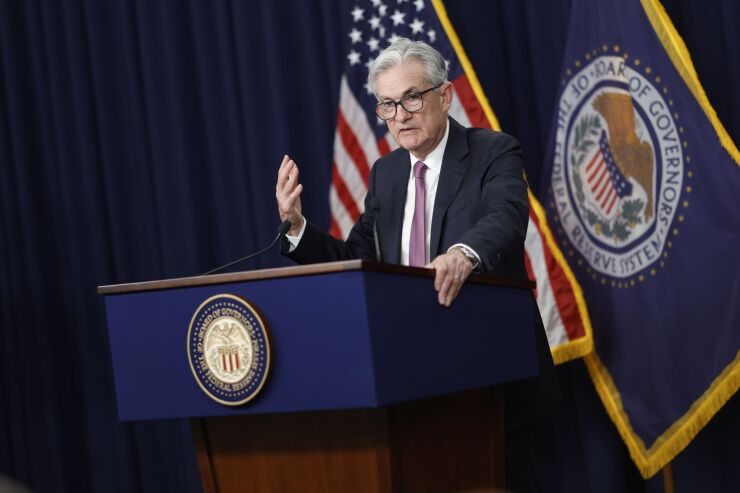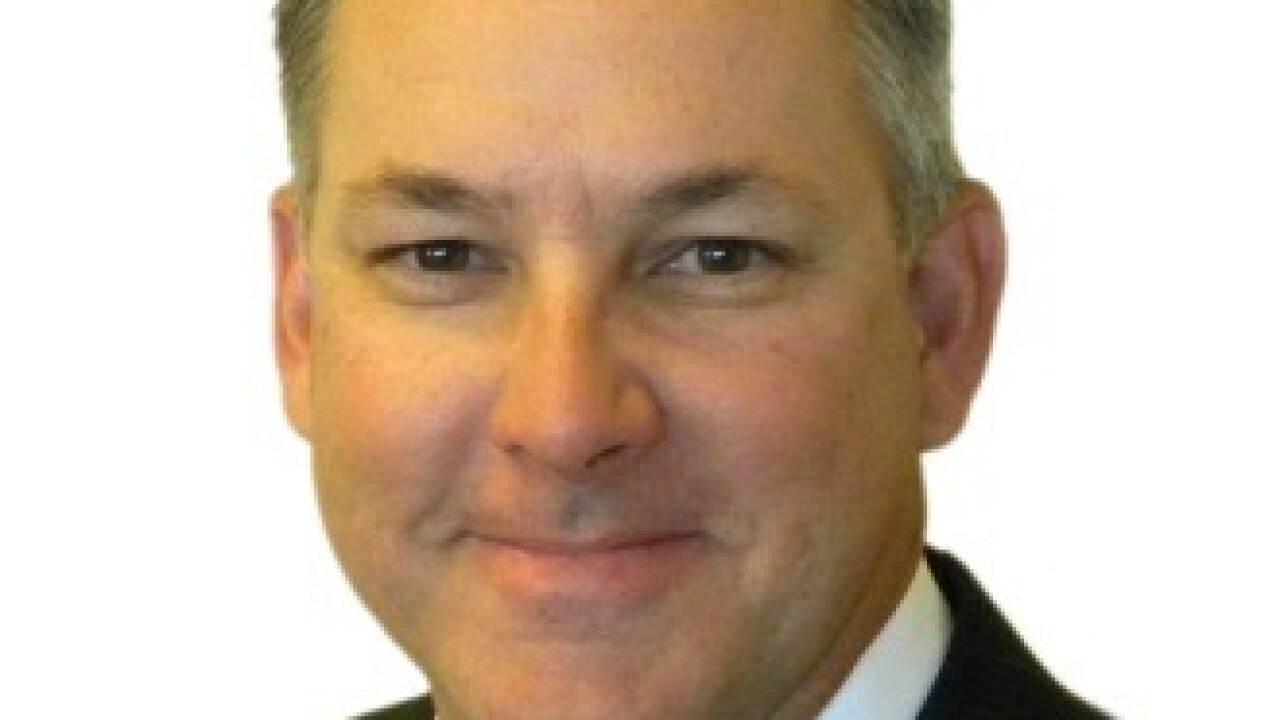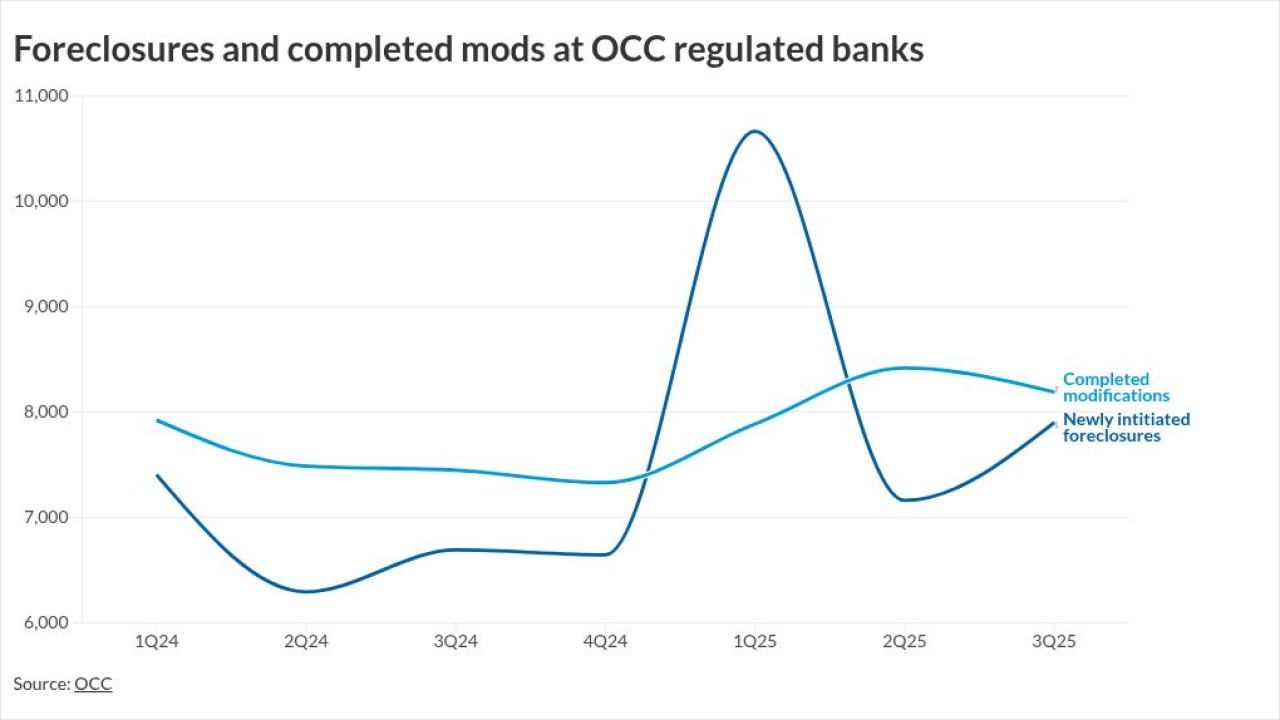In his
At minimum, the proclamation seems to mark an end to the rapid policy rate reductions that defined the final months of 2024, a stretch that saw the Federal Open Market Committee cut rates at three straight meetings, bringing the target range for its benchmark rate down a full percentage point from the post-pandemic peak.
That is not to say the committee is done lowering rates. Most participants expect at least another couple of cuts before the end of 2025. But, rather, the focus is on right-sizing the restrictiveness of its policy to
For banks, how this process plays out will go a long way toward shaping customer demand for borrowing and market-making activities. It will also determine the appetite for mergers and acquisitions, both in the sector and more broadly. And for those still struggling under the weight of unrealized losses on long-dated securities, further policy rate reductions could bring much-needed relief to their balance sheets.
And while 2025 will be a pivotal year for the current Fed inflation-fighting campaign, it will also have implications for years to come.
Here are five monetary policy developments to track during the year ahead.
'Extent and timing'
In its last meeting, the FOMC voted to reduce its benchmark rate by a quarter percentage point, to a range between 4.25% and 4.5%. But its official statement on the move came with a notable new clause.
In the third paragraph of the statement, in which the committee gives guidance about future actions, it replaced the phrase "in considering additional adjustments" — language it adopted alongside its first rate cut in September — with "in considering the extent and timing of additional adjustments."
Trivial as it might seem, such a minor tweak amounts to a substantial policy adjustment for the Fed. Powell explained the deliberate revision during his post-meeting press conference.
"We coupled this decision today with the extent and timing language in the post meeting statement. That signals that we are at or near a point at which it will be appropriate to slow the pace of further adjustments," he said. "The slower pace of cuts for next year really reflects both the higher inflation reading that we have this year and the expectation inflation will be higher."
The commentary suggests the Fed is not inclined to cut rates again in January, barring a surprising dip in the labor market or inflation. The area to watch, both immediately after next week's meeting and in the subsequent months, is whether standing pat at the next meeting proves to be a
When the Fed was raising interest rates between 2022 and 2023, the idea of skipping hikes was floated but only came to pass once, as the committee opted to keep the target range between 5% and 5.25% in June 2023, before raising it once again the following month. From there, it remained unchanged for more than a year until the FOMC voted to cut in September.
Whether the rate cutting cycle follows a similar path will be determined by changes to inflation and employment, and the Fed's view of the path ahead.
Balance sheet runoff
Despite its recent moves to make interest rates less restrictive, the Fed has not changed its approach to its other key monetary policy tool: its
The central bank has continued to allow roughly $60 billion to roll off its books each month
The questions heading into 2025 are when the Fed will curb its runoff even further and at what point will it stop.
Overall, the Fed has reduced its assets by more than $2 trillion since the spring of 2022, a process that automatically reduces the liability side of its books. Most of this reduction has come out of the central bank's overnight reverse repurchase program, or ON RRP, through which money market funds and other counterparties lend to the Fed overnight.
Eventually, this reduction will reach another type of liability: reserves, or the holdings of commercial banks at the Fed.
Currently, the Fed sees the level of reserves as "abundant," or well in excess of what banks need to meet their liquidity requirements and settle day-to-day transactions. Policymakers would prefer that reserves were "ample," or just slightly more than what banks need.
What the Fed wants to avoid is shrinking its balance sheet to the point that reserves become scarce, an outcome that could cause banks to bid up reserve prices and clamor for short-term borrowings.
An
Whether that was the first sign of scarcity or merely a preview of things to come, the episode serves as a reminder that the Fed's balance sheet winddown cannot run on forever.
When do long rates catch up?
Despite the Fed's aggressive actions to ease monetary conditions, many of the most consumer facing interest rates, including those for mortgages and auto loans, have not come down commensurately.
In fact, the interest rate on the average 30-year fixed rate mortgage rose three-quarters of a percentage point between mid-September and late November. It fell for the first two weeks of December and is now trending up again.
This is because the federal funds rate influences short-term lending rates, while longer-dated products are benchmarked off 10-year Treasury yields, which are up nearly a full percentage point since the Fed began cutting. This trend is being driven by market expectations around inflation and overall uncertainty.
"They are affected to some extent by Fed policy, but they're also affected by many other things," Powell said during the December press conference. "Longer rates have actually gone up quite a bit since September … and those are the things that drive, for example, mortgage rates more than short-term rates."
At face value, falling short-term rates and rising long-term rates are welcomed developments for banks. The bigger the spread between the two rates, the greater opportunity they have for expanding net interest margins by lowering the rates they pay depositors and increasing the rates they charge to borrowers.
But, for banks hoping for an uptick in lending activity in 2025, the divergent rate paths mean borrow demand will likely remain muted for the time being.
During the December press conference, Powell said the Fed will continue tracking the developments in consumer facing loans, but he noted that the central bank is more concerned about the underlying factors driving those rates than the rates themselves.
The Trump effect
One reason for the recent uptick in 10-year yields — and in the uncertainty felt by
President-elect Donald Trump has championed a number of policies that could
While the incoming president expects these initiatives to revitalize domestic manufacturing, some economists worry that the higher material costs and potentially supply constraints resulting from tariffs combined with a surge in demand from lower taxes could be a recipe for inflation.
For the Fed, the challenge will be determining whether any uptick in prices as a result of these policies should be treated as a one-time — or transitory — shock to price levels, or as genuine inflation. The former might suggest keeping rates steady while the latter might call for a strong policy response.
In making such an assessment, FOMC members must also contend with the likelihood that Trump does not allow them to reach their conclusions in peace. The incoming president has a track record of speaking his mind about monetary policy and, as a candidate, he insisted that he should
Powell has said it is too soon for the Fed to make any decisions about how it will respond to Trump's policies, noting that many specifics must still be seen.
"What the committee is doing now is discussing pathways, and understanding, again, the ways in which … tariffs can affect inflation in the economy, and how to think about that," Powell said. "That puts us in position when we finally do see what the actual policies are, to make a more careful, thoughtful assessment of what might be the appropriate policy response."
He has also noted, time and again, that
"The financial markets do not want to see a politically driven Federal Reserve in terms of policy," Waller said during a public speaking
Framework review
While dealing with its meeting-to-meeting monetary policy decisions, the Fed will also be taking a bigger picture look at the topic in 2025.
Throughout the year, the Fed will be
The Fed's
The idea behind the change was to allow the labor market time to recover more fully rather than tighten monetary policy at the first sign of inflation.
Some
Whether FAIT actually inhibited the Fed's policymaking or not is debatable, but some Fed officials say the approach had flaws. In recent public remarks, Waller said the framework was
"It was a very backward working strategy in the sense that we had a problem for 10 years in the past," Waller said. "We thought [the slow recovery] was going to cause problems. We designed [the framework] thinking that problem was going to continue, and then within a year, the whole thing kind of blew up."
Yet, even if the Fed agrees that the old framework needs to go, it will have a hard time abandoning the principle set out in the last review: that the economy should be allowed to run a little hot if it means more job growth.
Taking a place against a backdrop of enhanced political scrutiny, the Fed's second-ever framework review could prove tricky to traverse.








